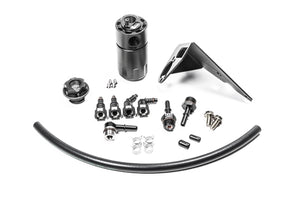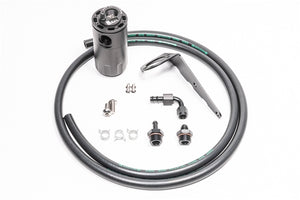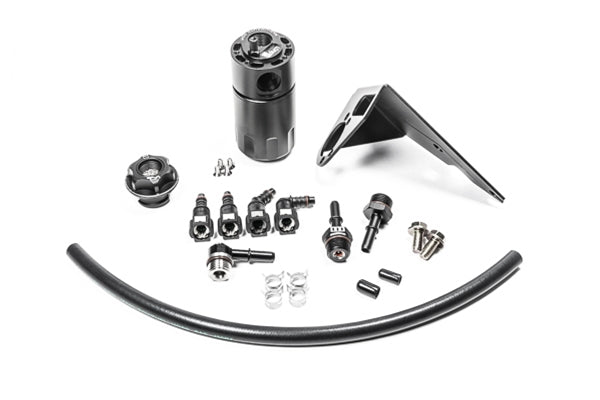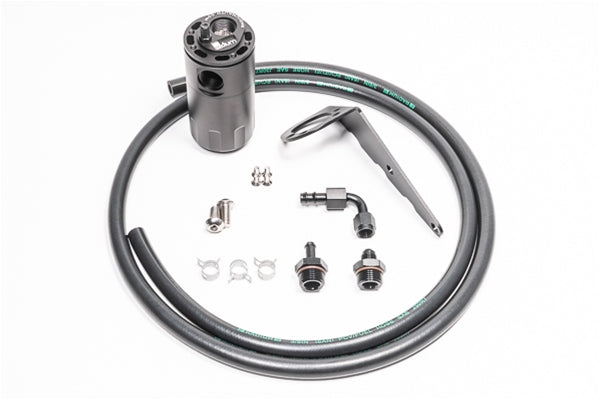



COMPATIBILITY
- See kit details below for individual compatibility information on each.
OVERVIEW
The catch can draws out oil and water condensation from the crankcase gasses that would otherwise be drawn into the intake manifold. This prevents oil buildup in the intake, intercooler system walls, throttle body, and intake manifold. This effectively raises the octane, can increase engine performance from cleaner inlet air, and can lower hydrocarbon emissions. The closed system prevents unwanted oil vapors from entering into the cabin. Catch can kits include everything needed for a complete installation.
FLUID LOCK® CATCH CANS
In 2022, Radium Engineering implemented a revolutionary design change to the 7 fluid ounce standard catch can. An inherent problem always existed with typical catch cans when not serviced regularly. The fluid contaminants will eventually leave the reservoir pouring into the air intake system causing poor engine performance. To resolve this issue, Radium created the Fluid Lock® Catch Can. This contains a patented mechanism that prevents the reservoir from overfilling and traps the collected fluids until it is emptied.

FEATURES
- Direct fitment with no drilling required
- Large 10AN ORB inlet and outlet ports
- 4AN ORB drain port
- 2-step oil separation baffling
- O-ring sealed dipstick
- 7 fluid ounce capacity
- Patented Fluid Lock® system
COLLECTION & EMPTYING
The rate that your catch cans will collect oil and moisture contaminants will vary from one individual vehicle to the next, so there is no set emptying interval. PCV catch cans tend to collect more than CCV catch cans. You should check the level of your catch can using the integrated dipstick starting at 3-4 weeks of driving and repeat as needed to determine how often they should be emptied based on what you see.
Catch cans can be emptied by unscrewing the lower reservoir and removing it from the vehicle to dump out, or in cases where there is available space under the catch can, the Petcock Drain Kit can be installed and used to drain them.
In cases where oil collection is excessive you may have to address an issue with the engine. The reasons a catch can will collect an excess of oil include
- Excessive blowby from engine damage
- Crankcase windage from an over-full oil level
- Poor placement of breather ports and/or poor baffling inside breather ports
- PCV valve not closing and leaking under heavy load
 |
20-0260-FL CATCH CAN KIT, PCV, GM LS1/LS6 ENGINE, FLUID LOCKThe anodized aluminum catch can bracket mounts to the front RH side of the cylinder head. COMPATIBILITY
Use 20-0785-FL instead for the following Gen IV engines: LS2, LS3 and LS7. This catch can routes inline with the OEM PCV valve found on Gen III engines. INCLUDES
|
|
|
20-0785-FL CATCH CAN KIT, PCV, GM LS2/LS3/LS7 ENGINE, FLUID LOCKThe anodized aluminum catch can bracket mounts to the front RH side of the cylinder head. COMPATIBILITY
Use 20-0260-FL instead for the following Gen III engines: LS1 and LS6. NOTE: A PCV valve serves a few purposes in the crankcase; promote negative pressure and prevent boost pressure. Also, in the event of a backfire, the PCV valve prevents combustible vapors from igniting in the crankcase. This PCV catch can kit is compatible with both wet and dry sump engines. INCLUDES
|
Catch Can Kits, GM LS1/LS2/LS3/LS6/LS7 Engines
- Regular price
- Sale price
- $0.00
- Regular price
-
Couldn't load pickup availability
Install Instructions PDFs
Installation Instructions (PDF)This product is SEMA certified 49-state legal

Click on the image to view the SEMA Garage Certificate of Compliance.









